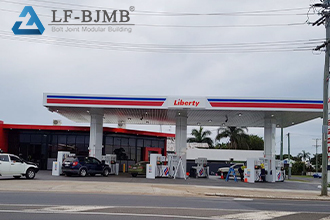
A steel-framed petrol station is a form of construction that uses steel as the main structural material and has some specific features that make it a more suitable choice in certain situations. The following are some of the features of steel-framed petrol stations:
Lightweight construction: Steel-framed petrol stations are lighter than traditional concrete structures, as the high strength and rigidity of steel allows for larger spans without the need for excessive bracing.
Faster construction: Steel structures can be prefabricated in a factory and then assembled on site, making them faster to construct than concrete structures. This helps to shorten the project cycle and get it up and running quickly.
Corrosion resistance: Petrol stations are exposed to corrosion from chemicals (such as oil), atmospheric conditions and groundwater, and steel structures are often better able to withstand these corrosive influences, with coatings and anti-corrosion treatments increasing their durability.
Disassembly and Relocatability: Steel-framed petrol stations are assembled in such a way that they can be disassembled, making them easy to maintain and remodel at a later stage. It is also relatively easy to dismantle and rebuild if relocation is required.
Design Flexibility: Steel structures are able to achieve larger spatial spans and are therefore more flexible in terms of design, allowing them to meet the needs of buildings of different shapes and sizes.
Cost-effectiveness: Steel structures may be more cost-effective than traditional concrete structures in some cases, especially considering the construction cycle and maintenance costs.
It is important to note that steel petrol stations also need to be designed and constructed in accordance with local regulations and standards to ensure safety and compliance with relevant codes.











 About Us
About Us 2023-12-27
2023-12-27


